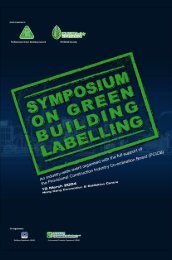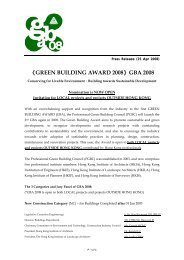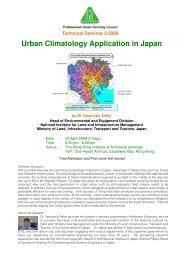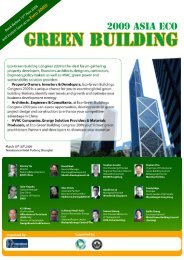10th Anniversary Booklet - The Professional Green Building Council
10th Anniversary Booklet - The Professional Green Building Council
10th Anniversary Booklet - The Professional Green Building Council
You also want an ePaper? Increase the reach of your titles
YUMPU automatically turns print PDFs into web optimized ePapers that Google loves.
Sparkling <strong>Green</strong>Biofuel in OperationBiofuels are usually classified into two types:In view of the above, there seems to be a vast market to beexplored. <strong>The</strong>refore, I have endeavored into a small investment inbiodiesel plant in Panyu, China.154Bio-ethanol, made from plant matter, mostly from corn, andBio-diesel, often from used oil, yellow grease, grease trap wasteand other sources.In this passage, I am concentrating on Biodiesel generating fromused oils and yellow grease.Biodiesel is “renewable” product, as it is generated mostly fromrecycled waste and plant seeds, and it is not as harmful as theconventional fossil fuel. Unlike crude oil, the sulpher contentof biodiesel is near to zero. According to a HKU study in 2003,mixing 20% biofuel into conventional fuels reduced smoke opacity(-16%), Carbon monoxide emission (-14%) and Hydrocarbonemission (-14%).At the same time, there is also reductionin engine power (-1%) in automobiles,and not all the engines can take purebiofuels. <strong>The</strong>refore, biodiesel is oftenmixed with conventional fuels. Fuel with5% biodiesel blend is termed B5, with10% blend, B10, and so on. Mandatedbiofuel blend laws around the worldwill be expected, China has alreadyenacted B10 mandates in ten provinces in 2010. Other countrieshave already set levels at B5 to B10. Europe has imposed taxesand other sanctions on foreign flights that exceed their carbonemission standard. As a result, jet fuel of flights to Europe willbe blended with biodiesel. According to reliable source, there isalready joint effort in China with Boeing to introduce biodiesel asaviation fuel. <strong>The</strong> energy experts projected global biofuel usagewill be increased by 70% by 2020, and doubled by 2025.<strong>The</strong> reason of choosing Guangdong is that the city has completedits legislation preventing used oils to be recycled into the foodoil market. <strong>The</strong>re is ample supply of waste oil, at 140,000 tonneper annum, and this amount of feedstock could generate 40,000tonne biodiesel each year. <strong>The</strong> supply of feedstock is mostimportant in this industry, as the feedstock would amount to 75%of the cost.<strong>The</strong>re has been research on alternative supply of feedstock.Jatropha Curcas ( 麻 瘋 樹 ), a poisonous plant that grow onmarginal land, that would not deprive the land for foodcrops, is one of the alternatives. <strong>The</strong> oil obtained from theseeds could generate biodiesel that yield 78% less carbonemission compared to fossil fuel. <strong>The</strong> Chinese Government hasestablished vast plantations in Yunnan and Sichuan. However, thisalternative is more suitable for state owned operations than toindividual operators.Likewise is the research on micro-algae, this feedstock willgenerate 38,000 liters of biodiesel per hectare, compared to 4,500to 9,000 liters in the case of jatropha. Again, this plantation is onlysuitable for large scale production centers.<strong>The</strong>re are currently three production centers in Hong Kong (oneof them is still in construction), the annual maximum productionrange from 60,000 tonne to 100,000 tonne respectively. <strong>The</strong>seplants obtain their feedstock from hotel groups, fast foodfranchises like the Maxim’s and Café de Coral. However, theseplants are not yet in full gear, sources revealed that they areoperating around 30-50% capacity, and the feedstock supply isbelieved to be a contributing reason.










